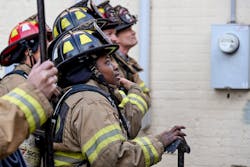Why do you exist? The question has perplexed all of humanity for thousands of years, and, still, individuals today in the information age seek to understand the very reason for their existence.
However, when an organization goes about developing a mission statement, it answers the questions of why it exists and what is its purpose.
A fire department’s mission statement provides the community, taxpayers, elected officials and, more importantly, employees with the reason for the agency’s existence.
Along with this statement, a department likely has a set of core values. I often hear that when rules or policies fall short, core values guide employee actions. Is that the sole purpose of core values? If it is, it’s a pathetic reason for core values, but it likely explains why many departments have been tricked into selecting easy, corporate-sounding ideals that carry little weight within fire service ranks.
Core values and mission statements thread a needle for organizations, showing everyone a department’s purpose, what the department is and how the department carries out its mission. Do the core values make a difference? Absolutely. Decades of empirical research show that well-communicated missions and values improve organizational outcomes and employee experiences. However, mission statements and core values also can be nothing more than words on paper. Consider it in these terms: The most extraordinary and capable piece of apparatus only is as good as the crew that operates the vehicle.
Chasing rabbits
The fire service faces many challenges as it struggles to adapt to a rapidly changing society. The biggest challenge that most departments face continues to be recruitment and retention. While they face that issue, many departments are trying to figure out how to increase their diversity.
I’ve had the pleasure of hosting firefighter-hiring roundtable meetings with fire service leaders across the United States, in an effort to find innovative ways to improve hiring practices. One example: The Springfield, MO, Fire Department (SFD) eliminated the written and physical agility tests from the hiring process. With the changes, the department increased the diversity within its ranks, particularly related to gender. Of course, with that came a different kind of challenge. While he presented this outcome, SFD Assistant Chief Olan Morelan said, “I’m not a woman, and I have no idea how to be a female firefighter.” It was a candid but powerful statement.
I have a sign on the door to my office: “Into the rabbit hole.” It’s a nod to Lewis Carroll’s “Alice’s Adventures in Wonderland,” but for my office, it indicates a place to lose oneself in a topic and to fully explore possibilities.
Often, we chase rabbits, not all of which turn out to be the right ones, but we learn from the attempt. Unfortunately, in many cases, the fire service chases the wrong answer when it tries to solve its diversity challenge. This also shortchanges what diversity means by placing it in a small frame, forgetting that it’s everything that makes each person different from another. That said, Morelan’s statement is powerful, because it’s indicative of the other rabbit, the one that we should be chasing: inclusion.
Inclusion
The dictionary is an amazingly underrated tool. Inclusive is defined simply by Merriam-Webster as “including everyone.” Sounds easy enough. The challenge is that we aren’t all things individually. In this, the first step toward inclusion is found: becoming self-aware of our own disposition. Our experiences have shaped our perspective, and those experiences are unique to each individual on this planet. Each of us grew up and was raised in a different household, town, school and environment. Although we might be able to appreciate a different perspective, we don’t know the reality of what someone else has lived and experienced.
Becoming an inclusive organization means first realizing that we all have unique perspectives and experiences that form our values and beliefs, which exert immense force on how we feel about the world around us.
Individuals don’t pave the way to a more inclusive organization alone. It takes organizational change. Undoubtedly, it will be more challenging than changing the color of the fire apparatus in your department, but it will be a lot more worthwhile.
Knowing where or how to start can be difficult when considering how to go about organizational change. As a fire chief, thinking about all of the possibilities can be overwhelming, but you can’t let analysis paralysis stop your effort.
Start by evaluating the purpose of your organization and how you are achieving that purpose—that’s right, your mission statement and core values. These serve as your why and how: why the organization exists and how the members of the organization live and exhibit daily in their work.
Be as inclusive as possible during the process of reviewing the mission statement and core values, and let your members lead the conversation on values.
Consider hiring an external facilitator for this process to avoid internal bias and other barriers as much as possible.
Finally, remember that you must leave room for people who the current membership might not represent. At a minimum, you must be deliberately inclusive of all of the possibilities within your community.
Belonging and accountability
When a new mission statement is created and values are selected for the organization, individual members should see themselves in those words and, thus, be ready to live by them. If these statements and values represent the members’ perspectives and those of the community, they will promote a sense of belonging, which will lead to more effective teams and better individual outcomes.
Mission statements also help to create accountability. If the department falls short, members and community partners should be there to call it out. Although they are mere words on paper, organizations can leverage mission statements and values to play a vital role in setting the tone for inclusion. These words can create a culture of inclusion and belonging for all members, and the process itself might serve as the first step in a more inclusive direction.
About the Author

Andrew Holter
Dr. Andrew Holter is an organizational psychologist who serves as the administrative services manager for the Wilmington, NC, Fire Department. Holter manages the department’s budgeting, human resources, accreditation, data analysis, strategic planning and organizational development. His 18-year career in emergency services began as a volunteer firefighter, followed by tenures as a career firefighter, a captain, an inspector, a paramedic, a life-safety surveyor and the chief of an EMS organization. Holter earned an associate degree in fire protection technology, a bachelor’s degree in fire science and a Master of Public Administration. In 2022, he completed his Ph.D. in organizational psychology. Holter is a certified HR professional from the Society for Human Resource Management. He currently manages a consulting firm that provides specialized services to public safety agencies in strategic planning, studies and organizational development.
